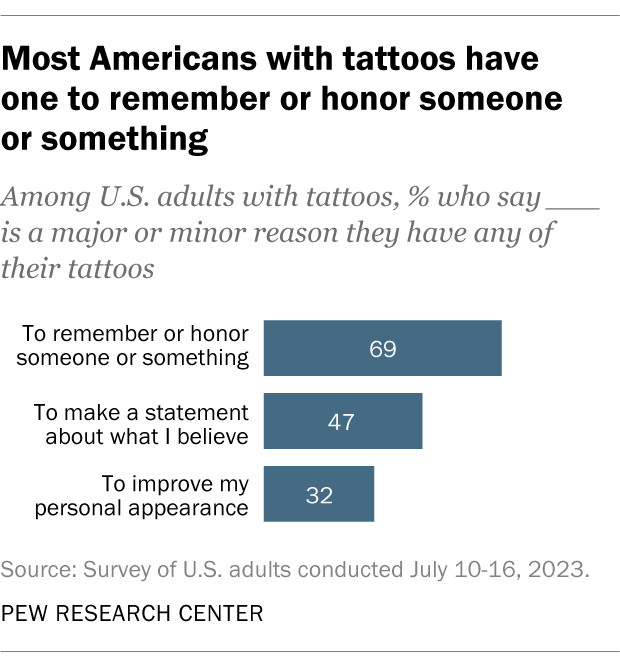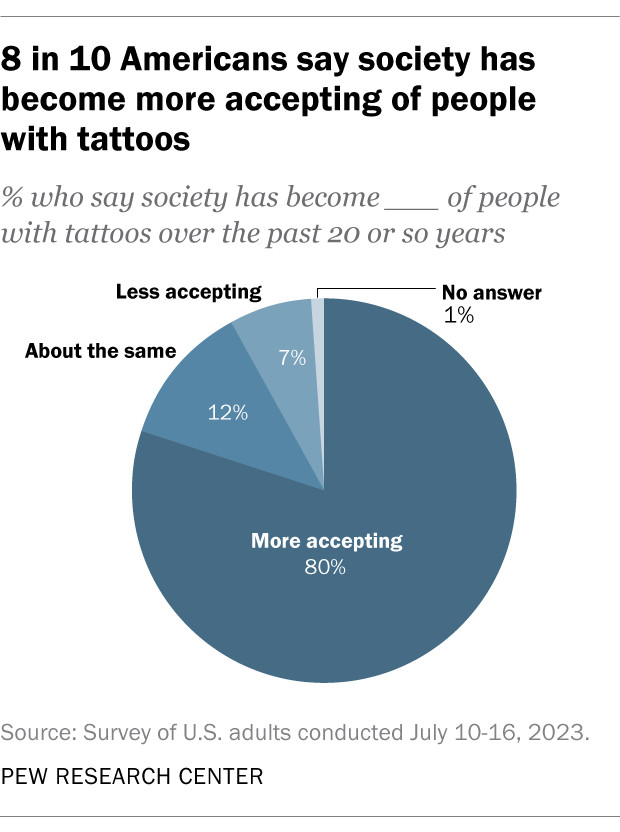Are you curious about how many people in America sport tattoos? This article from tattooat.com explores the fascinating world of tattoos and body art in the United States, providing insights into the prevalence, motivations, and perceptions surrounding tattoos. Discover the latest tattoo statistics, explore diverse tattoo designs, and connect with talented tattoo artists—all within tattooat.com! Dive in and explore this captivating art form.
1. What Percentage of Adults in the United States Have Tattoos?
Approximately 32% of adults in the United States have at least one tattoo, according to recent surveys. This shows a significant portion of the American population embraces tattoos as a form of personal expression. Let’s break down this statistic further to understand the demographics and motivations behind getting inked.
1.1. How Does Tattoo Prevalence Vary by Gender?
Interestingly, women are more likely than men to have tattoos. About 38% of women have at least one tattoo, compared to 27% of men. This difference is even more pronounced among younger women, with 56% of women ages 18 to 29 and 53% of women ages 30 to 49 sporting tattoos. This suggests that tattoos may be seen as a more socially acceptable or desirable form of self-expression among women.
1.2. What Is the Tattoo Prevalence Among Different Racial and Ethnic Groups?
Tattoo prevalence also varies significantly across different racial and ethnic groups. Black Americans lead the way, with 39% having a tattoo, followed by Hispanic Americans at 35%, White Americans at 32%, and Asian Americans at 14%. This highlights the diverse cultural influences and meanings associated with tattoos within different communities.
1.3. How Does Age Affect the Likelihood of Having a Tattoo?
Age plays a crucial role in tattoo prevalence, with younger adults being far more likely to have tattoos than older generations. Around 41% of adults under 30 have at least one tattoo, as do 46% of those ages 30 to 49. In contrast, only a quarter of adults ages 50 to 64 and 13% of those 65 and older have tattoos. This reflects the growing acceptance of tattoos as a mainstream form of self-expression among younger generations.
1.4. Does Education Level Impact Tattoo Prevalence?
Education level appears to have an inverse relationship with tattoo prevalence. Around 37% of those with some college education or less have a tattoo, compared to 24% of those with a bachelor’s degree and 21% of those with a postgraduate degree. This could be due to various factors, such as differing social norms or career aspirations.
1.5. What Is the Relationship Between Income and Tattoo Prevalence?
Similar to education, income level also seems to correlate negatively with tattoo prevalence. 43% of lower-income adults have a tattoo, compared to 31% of those in middle-income households and 21% of those in upper-income households. This could reflect differences in access to tattoo services, cultural values, or perceptions of tattoos as a form of rebellion or self-expression.
1.6. How Does Religious Affiliation Affect Tattoo Prevalence?
Religious affiliation also plays a role in tattoo prevalence. 41% of religiously unaffiliated adults have at least one tattoo, compared to 29% of those who are affiliated with a religion. This suggests that religious beliefs and practices may influence attitudes towards body modification.
1.7. What Is the Tattoo Prevalence Among the LGBTQ+ Community?
Members of the lesbian, gay, or bisexual (LGB) community are significantly more likely to have tattoos than their heterosexual counterparts. Around half (51%) of LGB Americans have at least one tattoo, with the share being particularly high among women in this group (68%). This could be due to the use of tattoos as a form of self-expression, identity affirmation, or solidarity within the LGBTQ+ community.
1.8. Do Political Affiliation and Location Impact Tattoo Prevalence?
Interestingly, there are no major differences in tattoo prevalence based on political party or location (urban, suburban, or rural). About a third of both Democrats and Republicans have tattoos, as do roughly a third of adults across different types of communities. This suggests that tattoos have become a widespread phenomenon that transcends political and geographical boundaries.
2. What Are the Primary Motivations Behind Getting a Tattoo?
Understanding why people choose to get tattoos can provide valuable insights into the cultural and personal significance of this art form. The most common reasons cited by tattooed Americans include honoring someone or something, making a statement about their beliefs, and improving their personal appearance.
2.1. Honoring or Remembering Someone or Something
The most prevalent reason for getting a tattoo is to honor or remember someone or something significant. 69% of tattooed adults say this is either a major or minor reason they got their tattoos. This could involve commemorating a loved one, celebrating a milestone, or paying tribute to a cherished memory.
2.2. Making a Statement About Beliefs
Another common motivation for getting a tattoo is to make a statement about one’s beliefs. Around 47% of tattooed adults say this is a reason they got their tattoos. This could involve expressing political views, religious beliefs, or personal values through symbolic imagery or meaningful quotes.
2.3. Enhancing Personal Appearance
Improving one’s personal appearance is also a factor for some people who get tattoos. About 32% of tattooed adults say they got at least one tattoo to enhance their physical appearance. This could involve accentuating certain features, adding visual interest, or simply expressing their personal style.
2.4. Demographic Differences in Motivations
Motivations for getting tattoos can also vary by demographic factors. For example, women are more likely than men to say remembering or honoring someone is a reason for their tattoo (73% vs. 63%). Similarly, Black adults are more likely than White or Hispanic adults to say making a statement about their beliefs or improving their personal appearance is a reason for their tattoo. These differences highlight the diverse cultural and personal meanings associated with tattoos.
 A bar chart showing that most Americans with tattoos have one to remember or honor someone or something
A bar chart showing that most Americans with tattoos have one to remember or honor someone or something
3. Do People Ever Regret Getting a Tattoo?
While most tattooed Americans do not regret their decision, a significant minority (24%) say they have at some point regretted getting one or more of their tattoos. This highlights the importance of careful consideration and thoughtful decision-making before getting inked.
3.1. Regret by Ethnicity
Tattoo regret varies across ethnic groups, with 30% of tattooed Hispanic adults reporting regret, compared to 23% of White adults and 21% of Black adults.
3.2. Regret by Education
Education also plays a role in tattoo regret, with 25% of tattooed adults with some college or less education expressing regret, versus 19% of those with a bachelor’s degree or more.
4. How Likely Are Untattooed Americans to Get a Tattoo in the Future?
The vast majority (85%) of Americans without tattoos say they are not very likely to get one in the future. However, a small percentage (6%) say they are extremely or very likely to do so, indicating a potential for future growth in tattoo prevalence.
4.1. Future Tattoo Intentions by Age
Younger adults are significantly more likely than older adults to consider getting a tattoo in the future. 19% of those under 30 say they are extremely or very likely to get a tattoo, compared to just 1% of those 65 and older.
4.2. Future Tattoo Intentions by Ethnicity
Ethnicity also influences future tattoo intentions, with 13% of untattooed Hispanic adults saying they are extremely or very likely to get a tattoo, compared to 3% of White adults.
4.3. Future Tattoo Intentions by Income
Income level also plays a role, with lower- and middle-income adults being more likely than upper-income adults to consider getting a tattoo in the future.
 A bar chart showing that about 2 in 10 adults under 30 who don't have a tattoo are extremely or very likely to get one
A bar chart showing that about 2 in 10 adults under 30 who don't have a tattoo are extremely or very likely to get one
5. How Do Untattooed Americans Perceive Those with Tattoos?
The perceptions of untattooed Americans towards those with tattoos can provide insights into the social acceptance and cultural significance of tattoos. While most untattooed adults (66%) say seeing a tattoo leaves them with neither a positive nor negative impression, a significant minority (29%) express a more negative than positive impression.
5.1. Perceptions by Gender
Men without tattoos are slightly more likely than women without tattoos to have a more negative impression of someone with a tattoo (32% vs. 27%).
5.2. Perceptions by Age
Age also influences perceptions, with older adults being more likely to view tattoos negatively. 40% of Americans ages 65 and older say seeing someone with a tattoo gives them a more negative impression, compared to younger adults.
6. Has Societal Acceptance of Tattoos Changed Over Time?
The vast majority of Americans (80%) believe society has become more accepting of people with tattoos over the past 20 years. This reflects the growing mainstream acceptance of tattoos as a form of self-expression and personal identity.
6.1. Factors Contributing to Increased Acceptance
Several factors may have contributed to the increased societal acceptance of tattoos. These include the growing visibility of tattoos in popular culture, the increasing number of celebrities and public figures with tattoos, and the changing attitudes of younger generations towards body modification.
6.2. Remaining Challenges and Stigmas
Despite the growing acceptance of tattoos, some challenges and stigmas may still persist. These could include concerns about professional image, cultural or religious objections, and negative stereotypes associated with tattoos.
 A pie chart that shows most Americans say society has become more accepting of people with tattoos.
A pie chart that shows most Americans say society has become more accepting of people with tattoos.
7. Exploring Tattoo Styles and Trends
The world of tattoos is constantly evolving, with new styles, techniques, and trends emerging all the time. Some of the most popular tattoo styles include traditional, realism, watercolor, geometric, and minimalist.
7.1. Traditional Tattoos
Traditional tattoos, also known as old-school tattoos, are characterized by bold outlines, vibrant colors, and classic imagery like anchors, roses, and eagles.
7.2. Realism Tattoos
Realism tattoos aim to replicate photographs or real-life images with stunning accuracy, often requiring highly skilled artists and meticulous attention to detail.
7.3. Watercolor Tattoos
Watercolor tattoos mimic the look of watercolor paintings, with soft, blended colors and a fluid, ethereal quality.
7.4. Geometric Tattoos
Geometric tattoos feature intricate patterns, shapes, and lines, often creating visually striking and symmetrical designs.
7.5. Minimalist Tattoos
Minimalist tattoos embrace simplicity and understatement, using clean lines, small designs, and minimal shading to create subtle yet meaningful body art.
8. Finding Inspiration and Designs on tattooat.com
If you’re considering getting a tattoo, tattooat.com is an excellent resource for finding inspiration, exploring different styles, and connecting with talented artists. The website offers a vast library of tattoo designs, ranging from classic motifs to cutting-edge creations.
8.1. Browsing Tattoo Galleries by Style
tattooat.com allows you to browse tattoo galleries by style, making it easy to find designs that match your personal taste and preferences. Whether you’re drawn to traditional Americana, intricate Japanese designs, or modern minimalist art, you’ll find a wealth of inspiration on the site.
8.2. Discovering Unique and Custom Designs
In addition to pre-designed tattoos, tattooat.com also features custom designs created by talented artists. This is a great option if you’re looking for a one-of-a-kind tattoo that truly reflects your personality and story.
8.3. Saving and Sharing Favorite Designs
tattooat.com makes it easy to save your favorite tattoo designs and share them with friends or potential artists. This can help you narrow down your options and get valuable feedback before making a final decision.
9. Finding the Right Tattoo Artist and Studio
Choosing the right tattoo artist and studio is crucial for ensuring a safe, enjoyable, and high-quality tattoo experience. Look for artists with a strong portfolio, positive reviews, and a commitment to hygiene and safety.
9.1. Researching Artists’ Portfolios and Styles
Before choosing an artist, take the time to research their portfolio and make sure their style aligns with your vision. Look for artists who specialize in the type of tattoo you’re interested in, whether it’s realism, watercolor, or traditional.
9.2. Reading Reviews and Testimonials
Reading reviews and testimonials from previous clients can provide valuable insights into an artist’s skills, professionalism, and customer service. Look for artists with consistently positive feedback and a reputation for exceeding expectations.
9.3. Checking for Licensing and Safety Standards
Ensure that the tattoo studio is properly licensed and adheres to strict safety standards. This includes using sterilized equipment, following proper hygiene protocols, and providing clear aftercare instructions.
9.4. Booking Consultations and Discussing Ideas
Schedule consultations with potential artists to discuss your ideas, ask questions, and get a sense of their personality and approach. This will help you determine whether they’re a good fit for your needs and preferences.
10. Tattoo Aftercare and Maintenance
Proper aftercare is essential for ensuring your tattoo heals properly and remains vibrant for years to come. Follow your artist’s instructions carefully and be diligent about cleaning, moisturizing, and protecting your tattoo.
10.1. Cleaning and Moisturizing
Gently clean your tattoo with mild soap and water several times a day, and apply a thin layer of fragrance-free moisturizer to keep the skin hydrated.
10.2. Avoiding Sun Exposure
Protect your tattoo from direct sun exposure by wearing loose-fitting clothing or applying sunscreen with a high SPF.
10.3. Staying Hydrated and Healthy
Staying hydrated and maintaining a healthy lifestyle can also promote optimal tattoo healing and longevity.
10.4. Seeking Professional Advice
If you experience any signs of infection or complications, consult a healthcare professional or your tattoo artist immediately.
11. Tattoo Removal Options
For those who regret their tattoos, several removal options are available, including laser removal, surgical excision, and dermabrasion.
11.1. Laser Tattoo Removal
Laser tattoo removal is the most common and effective method, using concentrated light beams to break down the tattoo ink into smaller particles that the body can eliminate.
11.2. Surgical Excision
Surgical excision involves cutting out the tattooed skin and stitching the remaining skin together, typically used for smaller tattoos.
11.3. Dermabrasion
Dermabrasion involves sanding down the tattooed skin with an abrasive tool, which can be painful and may leave scarring.
11.4. Consulting with Professionals
Consult with a qualified dermatologist or tattoo removal specialist to determine the best option for your specific tattoo and skin type.
12. The Cultural Significance of Tattoos in America
Tattoos have a rich and complex history in America, dating back centuries and encompassing diverse cultural influences. From traditional tribal tattoos to modern artistic expressions, tattoos have served as symbols of identity, belonging, rebellion, and self-expression.
12.1. Historical Perspectives
Historically, tattoos have been used by various Native American tribes, military personnel, and marginalized groups to mark status, commemorate events, or express personal beliefs.
12.2. Modern Interpretations
In modern America, tattoos have become increasingly mainstream, embraced by people from all walks of life as a form of personal adornment and artistic expression.
12.3. Cultural Appropriation Considerations
It’s important to be mindful of cultural appropriation when choosing tattoo designs, respecting the origins and meanings of symbols and imagery from different cultures.
13. Debunking Common Tattoo Myths
Many myths and misconceptions surround tattoos, often based on outdated stereotypes or lack of information. Let’s debunk some of the most common tattoo myths:
13.1. Tattoos Are Unprofessional
While some employers may have restrictions on visible tattoos, many companies are becoming more accepting of tattoos, recognizing them as a form of personal expression.
13.2. Tattoos Are Painful
Pain tolerance varies from person to person, and while some areas of the body are more sensitive than others, many people find the pain of getting a tattoo to be manageable.
13.3. Tattoos Are Permanent
While tattoos are generally considered permanent, removal options are available for those who regret their ink.
13.4. Tattoos Are Only for Rebels
Tattoos are embraced by people from all walks of life, regardless of their personality, profession, or background.
14. Navigating Tattoo Regulations and Laws
Tattoo regulations and laws vary from state to state, covering aspects like licensing, age restrictions, and safety standards.
14.1. Age Restrictions
Most states require individuals to be at least 18 years old to get a tattoo, while some may allow minors to get tattoos with parental consent.
14.2. Licensing Requirements
Tattoo artists and studios are typically required to obtain licenses and permits to operate legally, ensuring they meet certain safety and hygiene standards.
14.3. Safety Standards
Tattoo studios are subject to inspections and regulations to ensure they maintain a clean and safe environment, using sterilized equipment and following proper hygiene protocols.
15. The Future of Tattoos in America
As societal attitudes towards tattoos continue to evolve, the future of tattoos in America looks bright. With growing acceptance, innovative techniques, and a vibrant artistic community, tattoos are poised to remain a significant form of self-expression and cultural identity for generations to come.
15.1. Technological Advancements
Technological advancements are constantly pushing the boundaries of tattoo art, with innovations like 3D tattoos, interactive tattoos, and temporary tattoos offering new possibilities for self-expression.
15.2. Growing Acceptance and Mainstream Adoption
As tattoos become more mainstream, they are likely to be increasingly embraced in professional settings, cultural institutions, and everyday life.
15.3. The Role of tattooat.com in Shaping the Future
tattooat.com plays a vital role in shaping the future of tattoos in America by providing a platform for artists to showcase their work, connecting clients with talented professionals, and educating the public about the art, culture, and science of tattoos.
16. Conclusion
The prevalence of tattoos in America reflects a growing acceptance of body art as a form of personal expression. As attitudes evolve and new trends emerge, tattoos will continue to play a significant role in shaping American culture and identity. Ready to explore the world of tattoos? Visit tattooat.com today for inspiration, artist connections, and expert advice. From personalized ink to expressive body art, discover your perfect tattoo and join the vibrant community of tattoo enthusiasts! Dive into the art, embrace your individuality, and let your skin tell your story.
Address: 1825 SW Broadway, Portland, OR 97201, United States. Phone: +1 (503) 725-3000. Website: tattooat.com.
FAQ Section: Your Tattoo Questions Answered
1. How Common Are Tattoos in the United States?
Around 32% of adults in the United States have at least one tattoo, reflecting its increasing popularity as a form of personal expression.
2. Who Is More Likely to Have Tattoos, Men or Women?
Women are more likely to have tattoos than men, with approximately 38% of women and 27% of men sporting ink.
3. Which Ethnic Group Has the Highest Percentage of Tattoos?
Black Americans have the highest percentage of tattoos, with about 39% having at least one tattoo.
4. What Is the Most Common Reason People Get Tattoos?
The most common reason is to honor or remember someone or something significant, cited by 69% of tattooed adults.
5. Do Many People Regret Getting Tattoos?
While most don’t, about 24% of tattooed Americans have regretted getting one or more of their tattoos at some point.
6. Are Younger or Older Adults More Likely to Get Tattoos?
Younger adults are more likely to get tattoos, with about 41% of those under 30 having at least one tattoo.
7. How Has Society’s Acceptance of Tattoos Changed?
About 80% of Americans believe society has become more accepting of people with tattoos over the past 20 years.
8. What Should I Consider Before Getting a Tattoo?
Consider the design, the artist’s style, studio hygiene, and your personal motivations to ensure you’re making an informed decision.
9. How Do I Find a Reputable Tattoo Artist?
Research artists’ portfolios, read reviews, check for licensing and safety standards, and book consultations to discuss your ideas.
10. What Is the Best Way to Care for a New Tattoo?
Keep the area clean and moisturized, avoid sun exposure, stay hydrated, and follow your artist’s specific aftercare instructions for optimal healing.

